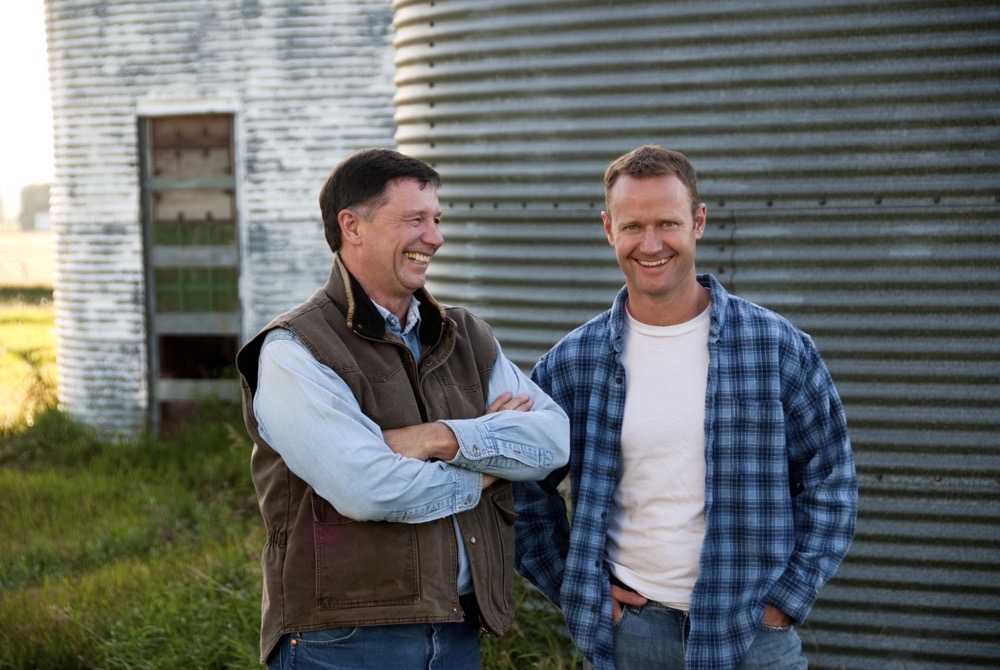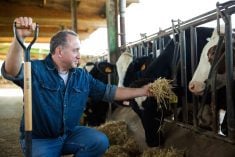The year is at half-time, and you’re the coach. Most of the crop is in the ground, the spring rush is coming to an end, the team is winded.
It’s a time when you can make a difference. You can be in charge; you can draw up new plays, analyze your strategy and motivate your players.
You can be the game changer for your farm business, re-committing yourself to your game plan and picking the right business priorities for the second half of the year, starting now to take the steps that will make it all happen.
Read Also

Managing ‘not-so-good’ vibrations
https://www.youtube.com/shorts/eIHni5Q_ViU Are you getting bad vibes from someone with whom you usually feel quite connected? It can be tough for…
You can also be the one who observes, listens and notices.
Here are five big ideas for your clipboard this summer, and some preplanning tips and ideas to get you started.
In sports, they say championships get won in the off-season. Heck, in farming these days, it’s the playoffs all year long.
1. Match equipment to your land base
Matching your equipment to your land base requires you to somehow balance the benefits of timely operations against the costs of excess capacity, all in the midst of fluctuating grain prices and unpredictable weather.
All spring, you’ve been walking this tight rope between efficiency and cost, so now is a great time to at least begin thinking about trading up or scaling down equipment, or even acquiring more land.
Before you make any decisions, though, it’s good to benchmark against other farmers and look at your machinery relative to your investment in land. When Ted Nibourg, Alberta Agriculture and Rural Development business management specialist in Stettler, analyzed Statistics Canada data for Alberta, he found Alberta farmers’ machinery investment as a percentage of total farm capital has dropped almost linearly from a high of 17.87 per cent in 1998 to a low of 10.45 per cent in 2013. Machinery investment as a percentage of land and equipment went from 24.81 per cent in 1998 to 12.36 per cent in 2013.
“I strongly suspect the percentage change can be attributed to increased land prices,” Nibourg says.
A better benchmark for managers to consider may be their machinery investment per acre divided by the long-term average gross revenue per acre. This ratio is a good guideline to start sizing equipment to acres. Economies of scale and higher commodity prices help reduce the ratio, although poor weather can increase the ratio in the short term.
The long-term average for Alberta farmers is 1.59 for crop producers, ranging from a high of 2.29 in 2003 to a low of 0.88 in 2012. This means the average farmer in Alberta has $1.59 to $2.29 invested in machinery for every $1 they receive in gross revenue annually.
As a guideline, your machinery investment should not exceed 2.0 times your gross revenue per acre, says Nibourg.
Nibourg also takes it a step further. The current average ratio of 1.59 with average gross revenues of $250 per acre means the machinery investment is $397.50 per acre.
When you include depreciation at 10 per cent, this results in a machinery fixed cost of $39.75/acre.
Increased crop returns, the lack of systematic machinery replacement, and increased farm size have impacted this ratio, says Nibourg.
For livestock producers, the long-term average ratio is 1.09, ranging from a low of 0.8 in 2001 to a high of 1.28 in 2013. The overall lower ratio in the livestock sector can be attributed to a lower machine requirement, says Nibourg, who adds, “The ratio increase will likely reverse itself with the increased returns experienced by the livestock sector during the last two years.”
It’s important to consider your ratio over the long term because short-term variability can result in a misdiagnosis of machinery requirements. The overall ratio may also appear favourable but a weak link could show up in a critical operation. “Machinery evaluation should be ongoing and done operation by operation,” says Nibourg.
2. Time to get to work on succession, instead of worrying about it
Before you call the lawyers and accountants, before you change your will or form a corporation, and even before you have a big family meeting and bring in a succession planner, take some time to gather your thoughts about succession.
Make the transition from wondering about farm transfer to actually thinking about it. Maybe crunch some numbers and start talking with your family.
Grant Robinson, national director of BDO’s SuccessCare Program says it helps the process if you take some time to figure out what you’d like the future to look like. Then talk to your kids about your vision, and discuss some ways to resolve the factors that may stop you from achieving it.
Robinson suggests you start with a workbook he helped develop, which you can find under the succession/business transition tab at takeanewapproach.ca. It may help you formulate a vision.
Think about what you’d like to see for the business in 10 years (i.e. two truck-leases) for the ownership and for the family. Then write it down. Robinson has found that by getting farmers to think in these time frames, they aren’t too intimidated, but it still keeps the process going. It’s a short enough time to give it a sense of urgency, yet long enough not to stress it into a stall.
Besides, almost everyone has worked with five-year plans for their business, so they understand what these horizons might look like. A decade is a long time, and a lot can happen.
Start by figuring out what you need and want, and talk with your spouse about what you want that retirement to look like. Then, again, write it down. This will also help you get a good understanding of how much you’re going to want to live on in your retirement,
Another part of that discussion is considering what role you’d like to continue to have on the farm, and how and when you’d like to transfer management and financial control.
Once you’ve sorted out what you want, you need to share this vision and receive feedback from all your children. “I am a believer in getting the stakeholders engaged and identifying what needs to be done before you start with the technical,” says Robinson.
State your vision. Then listen. Is it clear you want a common outcome? Does the next generation really want to farm, or do they really just want to maintain an emotional attachment to the home farm? Maybe they just want the assets so they are equal to their siblings. These are very valid concerns and can be resolved in many ways, not just via farm ownership.
Everyone also needs to understand the difference between estate planning and succeeding a business. “A business is not like my grandfather’s watch. I have my grandfather’s watch in a frame mounted on the wall. You can’t do that with a business,” says Robinson.
Next, it’s time to sort through the things that will stop you from getting to the outcome you want, and what needs to be done to get results. This introduces a dose of reality for many families.
After you explain your vision for the farm, ask what your children want for their future. What are their priorities? Do they just want the land or do they want to try a different production system? Their ideas, hopes and fears might surprise you.
You might want to share some cash-flow statements and the average over many years so everyone understands the reality of the farm as it stands today. One way to sort out the difference between emotions and thoughts is to ask your children directly. If they want the farm, would they be willing to buy the assets? What they can afford to pay for them. Then you have a starting point unshackled from entitlement or guilt.
Although you love all your children equally, they’re not all likely to be equally good successors or to want the same thing. This is a time to listen and look for solutions. These conversations should help you decide how you might make your vision a reality, or if you have to tweak it or start again.
“Always honour the family first, the relationships, the traditions and culture, before the business,” says Robinson. “The business is separate.”
Some children get stuck in what Robinson calls “the golden handcuffs,” inheriting a farm and traditions that don’t allow them to do what they want to do with their lives. They work on their parents’ farm for years providing sweat equity and giving up on other opportunities. And when their parents die, the farm is split up equally among the siblings. Bitterness eats away at the family. “If parents are going to make this decision, they need to talk about it with their children,” says Robinson.
3. Get better at communication
Although communication between individuals can always be improved, the real goal, says farm family communication adviser Richard Cressman from New Hamburg, Ont., is to determine if your current communication level is acceptable.
For a farm business, Cressman says, communication is all about achieving the most effective movement of critical information needed for the business to profitably function. One way he assesses whether communication is working on the family farm is by asking if anyone feels or thinks that they do not know everything they need to know about how the business is running.
“Information must move amongst everyone who needs to know,” says Cressman. “Everybody in the business or in the family will tell you if they think this is happening effectively or if there are big gaps in the system.”
To drill down to the problem, he asks members of the family farm the following:
- Do you feel you are being listened to?
- Is your input acted on?
- Are there decisions where you think you should have input and do not?
- Could you do a better job of sharing information?
The solutions can be as simple as organizing regular meetings, or as high-tech as accessing cloud technology on smartphones. Moreover, what works well in one situation may not be even tolerable in another. For example, Cressman knows of situations where the two farming principals get along very well, but their spouses haven’t talked for years. There are hardly any extended family get-togethers. They lead separate lives away from the farm business. Yet it works.
Each family is unique, and while there are strategies that will work across the board, they need to be tailored and customized for the individual nuances and the different personalities of the family and the business, says Cressman.
Phone calls and text messages also can exchange information effectively. Cressman has worked with two managers who exchange information using an Excel spreadsheet stored in the cloud. Each of the managers can access this information from their cell phones and move a lot of information back and forth without actually talking to or texting each other. They’ve also evolved this to allow specific outside advisers to access this spreadsheet.
A low-tech solution is a whiteboard on which different individuals can post information, without needing to talk to each other. For example, Cressman has worked with a family farm with three principals and they have six whiteboards scattered strategically around the buildings, throughout the barn, milking parlour and office area. On another farm a couple of decades ago, Cressman suggested putting a white board in place to track time off for the owners and employees. It’s still being used.
A common way to improve communication is with meetings, but their format can vary based on the situation. For example, Cressman will have some families sit down every four to six weeks for a business meeting. Another family he works with connects on three-way or four-way phone calls once a week. “There is no magic and there is no perfect way to have meetings,” he says.
4. Wondering about incorporating?
Before you jump on the farm corporation bandwagon next winter, you probably should take some time to think about how it might work on your farm, learn more about it and book some outside help.
To better understand the basics about corporate structure and to decide if incorporation makes sense for your farm business, check out resources such as the Ontario agriculture ministry’s factsheet called “Farm Corporations” at omafra.gov.on.ca.
Farmers should be talking to their accountants to find out more about these technical issues and whether it makes sense to incorporate. “Things can get pretty complicated depending on the situation,” says Tom Blonde, chartered accountant and partner in Collins Barrow in Elora, Ont.
A financial analysis into whether the costs would outweigh the benefits of incorporation is key. To do this, you need to determine how much you are paying in tax now, including benefits like the Canada Child Tax benefit that you may not be receiving because your income is too high, versus how much you could save with a corporation net of the additional costs and complexity of having a company.
You’ll have the additional costs of more paperwork and filing corporate as well as personal income taxes. Also, after incorporation, you’ll need to contact all your customers and suppliers to ensure that payments and invoices are now made out in the name of your company rather than your old proprietorship or partnership. If invoices are not in the company’s name, the CRA may deny deductions to the company and/or include company income as personal income.
You might also find value in talking to a friend or a neighbour who has recently incorporated. However, every farm incorporation situation is different and your neighbour may have either a more complicated or a simpler corporate structure than you might need.
This summer might be a good time to ponder some of the logistics of how a corporation would work on your farm. “It is not always necessary or desirable to transfer all proprietorship or partnership assets to your company. This applies particularly to land, homes and marketing quotas,” says Blonde.
Now is a good time to get a grip on future plans for the properties. Before creating a plan to handle assets in or out of a corporation, know if you have used up your farm property capital gains exemption and if you need to roll properties in so you can write off interest and principal in the corporation.
If farm assets are put into a corporation, there’s less flexibility in transferring them to the next generation at less than fair market value and it’s more difficult to access your capital gains exemption in the future. Transferring these assets to the company could impact your personal income tax and any social benefits you receive, such as the Canada Child Tax Benefit. Also, if you transfer your personal home to the corporation, you will lose your principal residence capital gains exemption and be subject to a personal taxable benefit for the use of corporate-owned property.
However, these negative consequences may not matter in situations where you have maximized your capital gains exemptions or have no desire to transfer assets to the next generation. Also, if you want to transfer debt to the corporation, you’ll have no choice but to transfer enough assets to be able to assume this debt.
If you’ve decided to go ahead and incorporate your farm next winter, now is a good time to think about when you want to do it and who should do the legal part. You also might want to consider who would be your company’s directors and officers.
For more thoughts on considering incorporation check out Blonde’s article collinsbarrow.com.
5. Prepare for life’s inevitable changes
When everything is growing in the field, the last thing that comes to mind is your death, but we all have expiry dates, we just don’t know when. The mess left to clean up after poor estate planning can leave children and surviving spouses battling, and all of their inheritances in jeopardy.
So the time to begin estate planning is now, no matter how old you are. If you don’t have a will or if your personal situation has changed, now is the time to think about it and take concrete steps. Book an appointment with a lawyer next winter to get it done.
For many families, joint ownership and beneficiary designation, combined with a simple will, can do the job. Property such as bank accounts can easily be placed in joint title to pass to the survivor automatically. Sometimes it can take more, but at least start with a basic will.
The hiatus between seeding and harvest is a perfect time to think about naming your beneficiaries, including charities that mean a lot to you, and how you’d like the assets handled. With business owners, it’s really important to select someone to be your power of attorney, which allows a selected person access to assets and bank accounts in case you’re alive but are mentally incapacitated.
Similarly, you can select someone to make health-care decisions. A preferred health care document, commonly (but not legally) called a living will, assigns a person if you’re incapacitated, although it’s handled and called different things in different provinces.
Although writing a will or thinking about your estate may not be your favourite activity for a summer afternoon, take some quiet time to think about how you’d want things handled when you’re gone. Add in the complications of owning and operating a farm business, second marriages and blended families, because you need a plan worked out thoughtfully.
Then there’s the much-needed sharing information and other wishes with your family. Jolene Brown, a popular speaker, farm business adviser and farmer from Iowa, created a list of questions about how the farm operates and what the person wants. (whatever you do, write out your passwords and tell someone where this list is). For the full list go to www.jolenebrown.com.
Another idea to pursue this summer is writing an ethical will or a legacy letter. It’s not a legal document, but rather a way to share your life lessons, hopes and love, forgiveness and dreams for the future. Some are read at funerals, others are distributed while alive or at death.
This can work really well with farm families, says Grant Robinson. For more on this, check out ethicalwill.com.















